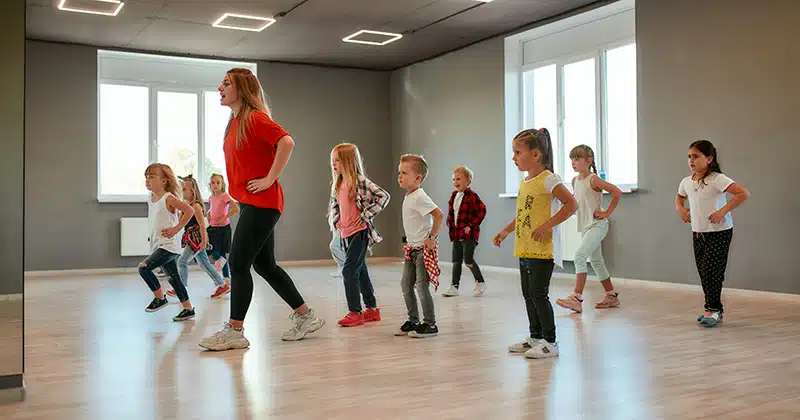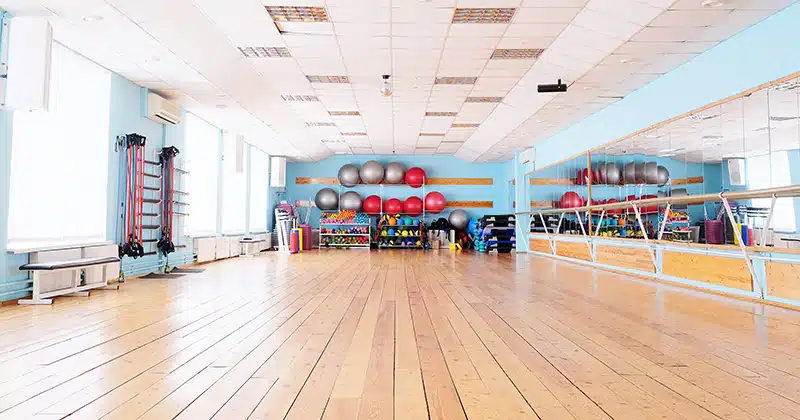For many, a dance studio is a special place where they’re encouraged to create beauty through movement. But the details must be just right for your studio to stand out and become a place students love to return to.
In this article we’ll discuss why a well-planned dance studio setup is so important.
We’ll share some ideas that touch on essential elements of a proper dance studio setup. Then, we’ll give you simple tips you can use to elevate your studio design right now.
Whether you’re just starting out or looking to make some changes, these ideas and tips can help you create a dance studio that students and staff will adore.
The Importance of a Well-Designed Dance Studio Setup
Taking time to carefully design and plan your dance studio setup is crucial. It shows your clients that you care about their experience.
A good setup can make your studio a success story. It moves beyond its function and becomes a place students and staff enjoy. The right layout, equipment, and environment can make them feel happy, safe, and excited to learn.
Here are some benefits of a well-designed dance studio setup:
It Provides a Better Learning Experience.
A good setup helps students learn. They can dance safely and improve their skills with enough space and suitable flooring.
It Saves Money.
Planning your layout can save you money. You’ll find the best way to use what you have without wasting resources or space. You also avoid the extra expense of fixing things later.
It Uses Space Efficiently.
In a dance studio, space is important. A smart setup ensures every part of your studio is used to its full potential. It should include appropriate spaces for multiple dance styles and classes.
It Creates a Welcoming Environment.
A creative studio space makes everyone feel welcome. Bright lights, clean floors, and an organized space contribute to a professional feel that clients will embrace. A friendly environment can also make more students want to join.
It Makes Your Studio Stand Out.
When your studio looks professional and functions seamlessly, people notice. Good design can make your studio the first choice for dancers in your area.
It Prioritizes Safety and Comfort.
Dance isn’t without risk. However, keeping dancers as safe and comfortable as possible is key. A well-designed studio setup should minimize chances of injury. Dancers should feel comfortable to practice without concern about getting hurt.
It Reflects Your Brand Identity.
Your studio’s setup can reveal your values as a business. If your studio looks professional and friendly, that’s how people will see your brand. This is vital because it tells new students what you’re all about before they even take a class. It helps you win their trust.
FROM ONE OF OUR PARTNERS: 9 Small Business Payment Options for Your Growing Business

Creating the Perfect Dance Floor
The dance floor is perhaps the most important component of your studio. It must be suitable for dancers to move, learn, and perform their best.
According to Dance Informa, “The floor is critical for both safety and performance of staff and students.”
Here are some considerations for picking a dance floor:
Compatibility
Different dance styles have different flooring needs. For tap, you need a floor that allows for a good sound. For ballet or modern, you might want a floor that’s quieter. Choose a floor surface that fits the dance classes you offer.
Subfloor
Subfloors that disperse the force when a dancer lands are best. This helps prevent pain and injuries from hard landings.
Some types of dance require a floor with a bit of bounce, but not too much. Consider whether a fully- or semi-sprung floor is a better fit for your classes.
Surface Material
Consider the best surface material for your studio floor. Vinyl is a versatile option with both plank and roll-out options and variable textures. It’s also easier to replace when worn. Hardwood looks nice and professional but might not work in all climates. It’s also more permanent and harder to maintain.
Optimizing Dance Studio Lighting
Good lighting in a dance studio is crucial. It helps set the mood and ensures everyone can see clearly.
When choosing lighting for your studio, consider different types of fixtures for various needs. Spotlights can highlight dancers and make choreography more visible. Softer, more diffused lighting can lend atmosphere to classes.
You want your studio to be bright enough for dancers to see their movements clearly but without harsh glares or shadows.
Mirrors can help. They not only allow dancers to view their form, but they also reflect light throughout the space. But be mindful of their placement. Avoid blinding dancers or creating reflections that make it hard to see.
Incorporating natural light can enhance the quality and ambiance of your studio. However, it’s essential to manage it properly.
Consider using blinds or curtains to control the amount of sunlight entering the studio. This lets natural light complement rather than detract from your lighting design.

Designing Functional Dance Studio Spaces
Each dance style and activity might need its own space and equipment. Here are some elements to keep in mind to make your dance studio work well for everyone:
Defined Areas
Set up different rooms or areas for each type of dance. Designated areas help keep classes organized and ensure every dance style gets the space and setup it needs.
Mirrors and Barres
Mirrors are necessary for dancers to see and improve their movement. They need to be placed thoughtfully, though. Find angles that aren’t going to cause glare.
Portable barres may be needed for ballet and some other dance styles, but they must be safely out of the way when not in use. Ensure you have enough room to place them against a wall and still have dance space.
Storage Solutions
Leave enough space to store equipment like mats, music systems, and props. Adequate storage keeps your studio neat and safe.
Sound Quality
Good acoustics are important. You want students to hear music and instructors clearly but without too much echo. Walls should obscure sound from outside and other rooms. Sound-proofing cuts down on distractions and helps everyone focus on learning.
Climate Control
Body heat, lighting, and lack of ventilation can make your studio feel hot and stuffy. You need a good HVAC system to keep air circulating. Air conditioning is often needed to control the temperature.
Easy Access
Your studio needs access big enough for pianos and oversized equipment to pass through. Double-doored entries can solve this problem.
Safety First
Protect your mirrors and barres if your studio hosts other activities like martial arts. You might need foam padding to keep everyone safe.
RELATED ARTICLE: How to Price Out Your Dance Studio
Enhancing the Ambience of a Dance Studio Setup
Your studio should inspire dancers. A creative and inviting space can make students feel more excited to learn.
Here’s how you can add some creativity and personality to your studio:
Inspirational Artwork
Hang art that makes people feel ready to dance. Pictures of famous dancers or beautiful dance poses can inspire your students in their pursuit of dance.
Energetic Colors
Choose a color palette that makes your space feel alive. Warm and vibrant colors can give energy to the space.
Studio Theme
Consider having a theme for your studio. Base it on your favorite dance style, your studio’s history, or something that makes your dance studio special.
Natural Touches
Adding plants and natural materials can make your studio feel more peaceful and organic.
Comfy Corners
Create a small area in your setup where people can relax. Add some cozy chairs and a shelf with books about dance. A living area can make your studio feel homier and give parents a place to wait for their students.
Show Your Brand
Your logo and colors are part of your brand identity. Show them off in your studio. Use the same colors and styles in your decor that are in your ads or website. This consistency helps people connect your brand with your studio space.
It’s all about making a space that shows off your studio’s personality and makes dancers feel at home.
FROM ONE OF OUR PARTNERS: Ideas for Small Business Marketing
Top Takeaway Tips for Your Dance Studio Setup
Here are some practical steps to make your dance studio the best it can be:
Examine Your Space Carefully.
Note the floor plan of your studio. Pay attention to room shape and size, the position of doors and windows, and how much space you have in each. This information will form the basis of all your dance studio setup ideas.
Assess Natural Light.
Observe how sunlight fills your studio at various times throughout the day. Natural light can make your space feel more welcoming and vibrant, but you’ll want to place mirrors accordingly. Also, be aware of your window covering options for the times they may be necessary.
Make a Detailed List of Essentials.
Jot down all the equipment and fixtures your classes will need. Your list might include mirrors, barres, sound equipment, and storage for props and costumes.
Identify Urgent Fixes.
Pinpoint any significant issues or repairs that must be addressed immediately. Ensuring a safe and functional space before classes begin is crucial.
Set a Realistic Budget.
Determine how much money you can allocate to setting up and enhancing your studio. Keeping a budget helps you prioritize your spending on essentials.
Imagine the Studio Atmosphere You Want.
Reflect on the ambiance you wish to create in your studio. Consider the emotions you want to evoke in your students and visitors the moment they step inside—whether it’s a sense of excitement, calmness, or inspiration.


